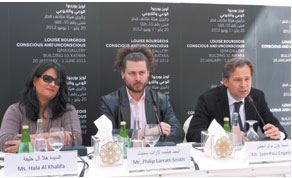By Peter Townson/Staff Reporter
The Louise Bourgeois exhibition ‘Conscious and Unconscious’ opens today at the QMA Gallery at Katara, offering art lovers a fascinating insight into the inspiration behind the renowned French artist’s work.

QMA’s head of education for the public arts programme, Hala al-Khalifa, Phillip Larratt-Smith and QMA’s director of public art, Jean Paul Engelen give details about the exhibition. PICTURES: Nasar T K
The exhibition, curated by Phillip Larratt-Smith will run until June 1, and contains 28 pieces, representing the first solo exhibition of Bourgeois’ work in the Middle East.
Throughout her 98 years, Bourgeois struggled with depression and underwent psychoanalysis for a large part of her life.
Questioning her role as a mother, her relationship with her own parents and her ideas related to family, home, love and other concepts, comprised a major part of her psychoanalysis, which in turn led to the creation of her work.
Bourgeois will be known to people in Doha following the installation of her bronze spider sculpture ‘Maman’ at the Qatar National Convention Centre.
Gulf Times spoke to curator, Larratt-Smith about the collection and what people can expect from the exhibition.
“This selection is a cross section of Louise’s work from 1947-2009 and it’s been selected to give a representative sampling of all of her work,” he said, adding “in my opinion she is one of the greatest artists of the 20th century and I think to show this work for the first time in the Middle East is fantastic and it’s great to be able to do it in Doha.”
“I think it also provides good context for ‘Maman’ which is installed at the National Convention Centre in Doha, so hopefully it will start a dialogue and initiate a wider understanding of her work here,” he noted.
He explained that he had curated a show in Buenos Aires last year, exploring the artist’s relationship to psychoanalysis inspired by the discovery of a number of writings she made while undergoing the process.
The range of work on display is impressive, especially considering the collection is comprised of only around 30 pieces. From the more literal sculptures of spiders to the abstract representation of family members, there is a huge variety of materials and creative processes featured in the exhibition.
However, integral to the whole collection is the psychology behind her work, and her ability to channel her unconscious into her art.
Indeed, this creativity was more of a necessity than a choice, according to Larratt-Smith, who said that Bourgeois went into psychoanalysis as she found herself slipping into depression.
Her body of work is hugely autobiographical, and many of the fabric items in the collection are made with materials used throughout her life, either to symbolise certain individuals or experiences.
This makes visiting the exhibition an extremely reflective experience, as the pieces inspire memories and personal relationships as important to the viewer as they obviously were to the artist.
Bourgeois was fond of a phrase “Be a mirror to me and I’ll be a mirror to you,” which is embodied in a number of the pieces which use reflective materials to inspire introspection.
Larratt-Smith described a number of the pieces which are particular highlights of the show. “The spiders have an accessibility which is why I think they have become the most iconic pieces Louise made,” he explained.
“The ‘Spider Couple’ is a fantastic piece, the wall spider is extraordinary, I love the fabric pieces we have, ‘Conscious and Unconscious’ is a major late work and ‘The Cell’ which has only been shown once before – it’s fantastic to be able to show in Doha and it’s a bit of a coup to have it here,” he said, adding “these to me are the highlights of the show.”
“I hope people will just come and approach it and not feel that they need to have any background information to understand it, but they should come to have an experience of the work,” he added.

